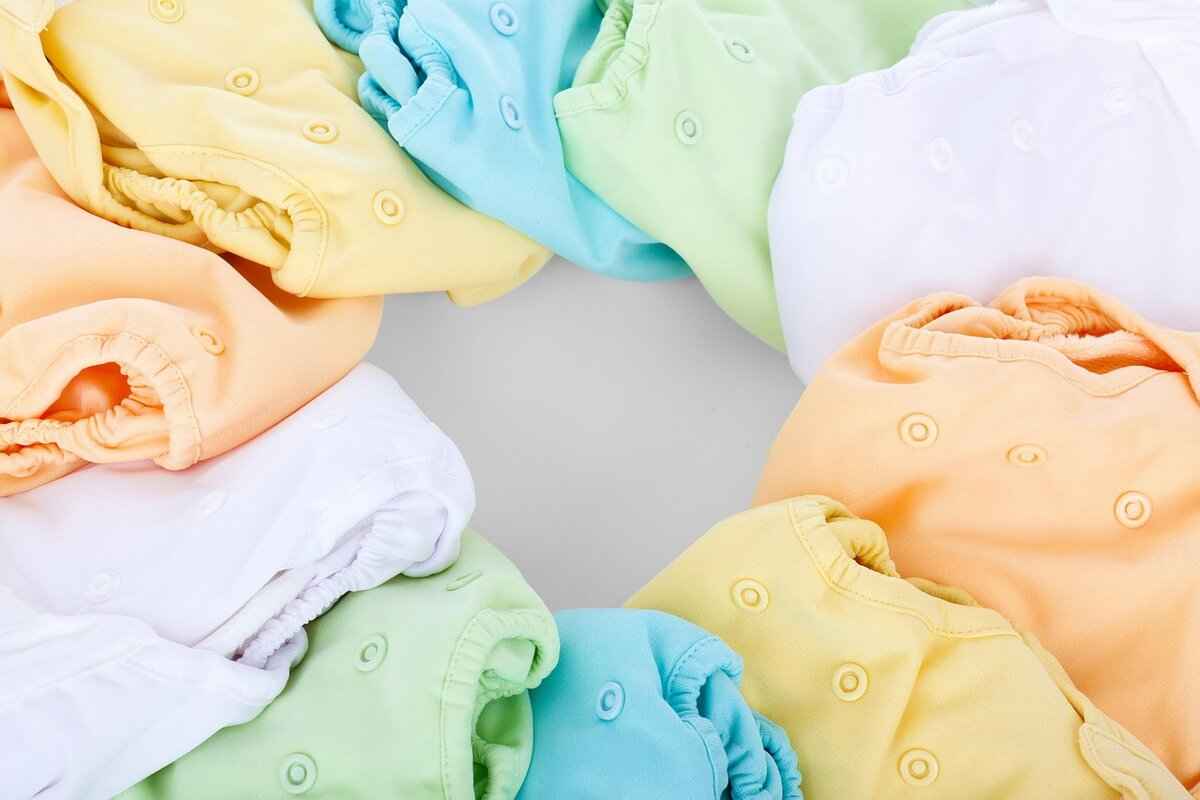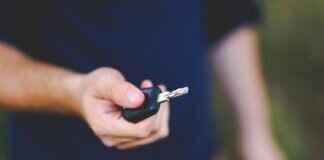This article provides a comprehensive guide on washing cloth diapers effectively, ensuring optimal hygiene and longevity. We will explore best practices, tips, and common mistakes to avoid for a cleaner, healthier experience.
Understanding Cloth Diaper Fabrics
Different fabrics used in cloth diapers have unique washing requirements. Common materials include cotton, bamboo, and microfiber. Each fabric has its own absorbency and durability characteristics. For example, cotton is highly absorbent but may require more care to prevent wear. Bamboo is eco-friendly but can be prone to odor retention if not washed properly. Microfiber is excellent for absorbency but should not be placed directly against the baby’s skin. Knowing these fabrics helps you choose the right washing methods to maintain their quality and absorbency.
Preparing Cloth Diapers for Washing
Before washing, it’s essential to prepare your cloth diapers properly. This includes rinsing, storing, and managing stains to ensure a more effective cleaning process. Rinsing your cloth diapers immediately after use can prevent stains and odors. Utilize a cold rinse to remove urine, while a hot rinse is more suitable for solid waste. Proper storage is also crucial; using a wet bag or pail can help contain odors and keep your laundry area clean.
Choosing the Right Detergent
Selecting the right detergent is crucial for washing cloth diapers. Not all detergents are created equal, and some can lead to build-up and irritation. Look for detergents that are free from fragrances, dyes, and softeners. Understanding the differences between liquid, powder, and eco-friendly detergents can help you make an informed choice that suits your washing needs. Additionally, using the correct amount of detergent is essential. Too much can lead to residue build-up, while too little may not clean effectively.
Washing Techniques for Cloth Diapers
The washing process can vary based on your machine type and the diaper fabric. Machine washing is generally more efficient, but hand washing can be a suitable alternative for delicate fabrics. Setting your washing machine to the right cycle and temperature is vital. A hot wash followed by a cold rinse is often recommended for thorough cleaning while protecting the fabric from damage.
Drying Cloth Diapers Safely
Proper drying techniques are essential for maintaining the integrity of cloth diapers. Air drying is the gentlest method and helps preserve the fabric, but machine drying can be convenient. Both methods have benefits and drawbacks; air drying can help maintain absorbency, while machine drying can be faster. Taking precautions during the drying process, such as not over-drying and avoiding high heat, can prevent wear and tear.
Common Mistakes to Avoid
Identifying and avoiding common washing mistakes can greatly improve your cloth diapering experience. Overloading the washing machine can prevent proper cleaning and rinsing, while ignoring care instructions can lead to damage. Each cloth diaper comes with specific care instructions, and following these guidelines is crucial for maintaining their effectiveness. Regular inspections for wear and tear can help you catch issues early, ensuring better hygiene and fabric care.
Maintaining Cloth Diapers Over Time
Long-term care for cloth diapers ensures they remain effective and hygienic. Regular maintenance can prevent the need for premature replacements. Knowing when it’s time to replace cloth diapers is essential for maintaining hygiene. Understanding the lifespan of different materials can guide your decisions. By implementing these best practices, you can ensure a cleaner, healthier experience for both you and your baby.

Understanding Cloth Diaper Fabrics
Cloth diapers have gained immense popularity among parents due to their environmental benefits and cost-effectiveness. However, one crucial aspect that often gets overlooked is the fabric composition of these diapers. Understanding the various fabrics used in cloth diapers is essential for proper care and maintenance, ensuring longevity and optimal performance.
Different fabrics used in cloth diapers have unique washing requirements. Knowing these fabrics helps you choose the right washing methods to maintain their quality and absorbency.
- Cotton: This natural fiber is a popular choice due to its softness and absorbency. Cotton diapers can withstand high temperatures, making them easy to wash. However, they may require more frequent washing to prevent odor buildup.
- Microfiber: Known for its excellent absorbency, microfiber is often used in inserts. It dries quickly but can be prone to compression leaks if not used correctly. Washing microfiber requires a gentle cycle to avoid damage.
- Bamboo: Bamboo fabric is eco-friendly and highly absorbent. It has natural antibacterial properties, making it a great choice for sensitive skin. Washing bamboo requires cooler temperatures to maintain its integrity.
- Hemp: Hemp is incredibly durable and absorbent, but it requires more time to dry. It is often blended with cotton for added softness. Washing hemp can be done at higher temperatures, but it is important to avoid fabric softeners that can reduce absorbency.
- Fleece: Typically used as a waterproof layer or for stay-dry liners, fleece is not absorbent but helps wick moisture away from the baby’s skin. Washing fleece requires cold water to prevent pilling.
Understanding these fabric characteristics allows parents to tailor their washing routines effectively. For instance, cotton and hemp can tolerate hot washes, while bamboo and fleece benefit from cooler settings. Additionally, combining different fabric types in one wash can lead to issues such as detergent buildup or uneven cleaning.
Furthermore, the choice of detergent plays a crucial role in maintaining the integrity of these fabrics. Some detergents may be too harsh for delicate materials like bamboo or microfiber, leading to reduced lifespan and absorbency. It’s advisable to select a detergent specifically formulated for cloth diapers to ensure compatibility with various fabrics.
By understanding the unique properties of each fabric, parents can implement the best washing techniques, ensuring their cloth diapers remain clean, effective, and safe for their little ones. This knowledge not only enhances the longevity of the diapers but also contributes to a healthier diapering experience for both babies and parents.

Preparing Cloth Diapers for Washing
Before you embark on the journey of washing your cloth diapers, it is crucial to ensure that they are properly prepared. This preparation phase can significantly influence the effectiveness of the cleaning process and the longevity of your diapers. Here’s a comprehensive guide on how to get your cloth diapers ready for washing.
- Rinsing Cloth Diapers: Rinsing your cloth diapers immediately after use is essential. This step helps in removing residual waste and prevents stains from setting in. A quick rinse can eliminate most of the odor and prepare the fabric for a deeper clean later. Aim to rinse in cold water, as this is effective for urine stains. For solid waste, a thorough rinse in warm water may be necessary.
- Storing Soiled Diapers: Proper storage of soiled diapers is equally important. Using a breathable wet bag or a diaper pail with a lid can help contain odors and keep your laundry area tidy. Avoid sealing them in airtight containers as this can cause bacteria to thrive. It’s advisable to store them in a cool, dry place until you are ready to wash.
- Managing Stains: Stains are a common concern for cloth diaper users. To manage stains effectively, consider using natural stain removers such as hydrogen peroxide or baking soda. Apply these solutions to the stained areas before washing. For particularly stubborn stains, you might want to soak the diapers in a mixture of water and vinegar for a few hours before the wash cycle.
- Sorting by Fabric: Different fabrics used in cloth diapers have varying care requirements. It’s beneficial to sort your diapers based on their fabric types. For example, microfiber, cotton, and bamboo all have unique washing needs. This ensures that each type is treated appropriately during the washing process, maintaining their quality and absorbency.
Essential Tips for Effective Preparation
- Timing is Key: Try to wash your cloth diapers every two to three days. Delaying washing can lead to buildup and odors, making it harder to clean them effectively.
- Use the Right Temperature: While preparing to wash, remember that water temperature plays a crucial role. Cold water is suitable for rinsing, but a hot wash is often necessary to kill germs and ensure thorough cleaning.
- Check for Inserts: If your cloth diapers come with removable inserts, ensure they are taken out before washing. This allows for a more effective cleaning process and prevents damage to the outer layer.
By following these preparation steps, you can ensure that your cloth diapers are ready for a thorough wash, leading to a cleaner, healthier experience for your baby. Proper preparation not only enhances the washing process but also extends the lifespan of your cloth diapers, making them a sustainable choice for your family.
Rinsing Cloth Diapers
Rinsing your cloth diapers immediately after use is a crucial step in maintaining their cleanliness and hygiene. This practice not only helps in preventing stains and odors but also enhances the overall washing process. Understanding the proper rinsing techniques can significantly improve your experience with cloth diapers.
When you rinse cloth diapers right after use, you are essentially removing the bulk of the waste and urine, which can set stains if left untreated. Stains are not just unsightly; they can also harbor bacteria and odors, leading to a less hygienic environment for your baby. By rinsing promptly, you can minimize these risks and prolong the life of your diapers.
There are a few effective rinsing methods to consider:
- Cold Rinse: This is often the first step in the rinsing process. A cold rinse helps to remove urine and any residual waste without setting stains. It’s a gentle approach that is suitable for all types of cloth diaper fabrics.
- Hot Rinse: If your diapers have come into contact with solid waste, a hot rinse can be beneficial. Hot water helps to break down and remove stubborn stains more effectively than cold water.
After the initial rinse, it’s important to store the soiled diapers correctly until you are ready to wash them. Use a wet bag or a dedicated diaper pail to contain odors and keep your laundry area clean. Avoid letting the diapers sit for extended periods, as this can lead to lingering smells and potential mold growth.
Additionally, consider the frequency of rinsing. If you are using cloth diapers full-time, rinsing immediately after each use should become a part of your routine. For those using cloth diapers part-time, it’s still advisable to rinse as soon as possible to maintain optimal hygiene.
Furthermore, be cautious about the water temperature you use for rinsing. While cold water is effective for urine, hot water should be reserved for cleaning solid waste. Always check the care labels on your diapers to ensure you are using the appropriate temperatures for the specific fabrics.
In summary, rinsing your cloth diapers immediately after use is a simple yet effective way to prevent stains and odors. By employing the right rinsing techniques and storing the diapers properly, you can enhance the washing process and ensure a healthier environment for your baby.
Cold vs. Hot Rinse
When it comes to washing cloth diapers, one of the most critical decisions revolves around the choice between cold and hot rinses. This decision is influenced by several factors, including the type of stains present and the specific fabric of the diapers. Understanding these elements can significantly enhance the cleaning process and ensure optimal hygiene.
Cold Rinse Benefits
- Effective for Urine Stains: Cold rinses are particularly effective in removing urine stains. The lower temperature helps to rinse away the liquid without setting the stains, making it easier to clean the fabric thoroughly.
- Energy Efficient: Using cold water is more energy-efficient, which can lead to cost savings on your utility bills. It’s an eco-friendly option that reduces your carbon footprint.
- Gentler on Fabrics: Cold water is less likely to cause wear and tear on the delicate fibers of cloth diapers, helping to maintain their integrity and prolonging their lifespan.
Hot Rinse Advantages
- Solid Waste Removal: Hot rinses are recommended for diapers that have been soiled with solid waste. The higher temperature helps to break down and remove stubborn residues more effectively.
- Sanitization: Hot water can provide a deeper clean by sanitizing the fabric, eliminating bacteria and odors that may linger after a cold rinse.
- Stain Removal: For tough stains, such as those from food or other organic materials, a hot rinse can help lift these marks more efficiently than cold water.
Choosing the Right Rinse Temperature
The choice between cold and hot rinses should also consider the fabric of the cloth diapers. For example, natural fibers like cotton may benefit from hot rinses to maintain cleanliness, while synthetic materials might be better suited for cold rinses to prevent damage. Always refer to the manufacturer’s care instructions for specific guidance.
Combining Rinse Types
Some parents find success in using a combination of both rinses. Starting with a cold rinse to remove urine and then following up with a hot rinse for solid waste can optimize cleanliness. This two-step process allows for effective stain removal while ensuring the longevity of the fabric.
Ultimately, understanding the specific needs of your cloth diapers and the types of stains you encounter will guide you in making the best choice between cold and hot rinses. By employing the appropriate rinsing methods, you can enhance the hygiene and durability of your cloth diapering system.
Storing Soiled Diapers
When it comes to cloth diapering, the way you store soiled diapers before washing can significantly impact both hygiene and the overall effectiveness of your cleaning routine. Proper storage methods not only help contain odors but also ensure that your laundry area remains clean and organized.
Why Proper Storage Matters
Storing soiled diapers correctly is essential for several reasons. First, it minimizes the risk of bacterial growth, which can thrive in warm, moist environments. Secondly, it helps to prevent unpleasant odors from permeating your home. Lastly, efficient storage makes the washing process easier and more streamlined.
Wet Bags vs. Pails
One of the most common methods for storing soiled diapers is using a wet bag or a diaper pail. Both options have their advantages:
- Wet Bags: These are typically made of waterproof materials and come with a zipper or drawstring closure. They are portable, making them ideal for outings or travel. Wet bags can be easily washed along with the diapers, ensuring that any lingering odors are eliminated.
- Diaper Pails: A dedicated diaper pail is another effective solution. Many pails come with odor-control features, such as a tight-fitting lid or a carbon filter. They can hold a larger quantity of diapers, making them suitable for home use. However, they may require more frequent cleaning to prevent odor buildup.
Best Practices for Storing Soiled Diapers
To maximize hygiene and minimize odors, consider the following tips:
- Rinse Before Storing: If possible, rinse the diaper immediately after use to remove any solid waste. This step can significantly reduce odors and stains.
- Use a Liner: If using a diaper pail, consider using a washable liner. This can help keep the pail clean and make it easier to transfer diapers to the washing machine.
- Avoid Overcrowding: Whether using a wet bag or a pail, avoid overloading it. This can lead to poor air circulation and increased odors.
- Keep It Cool: Store soiled diapers in a cool, dry place. High temperatures can exacerbate odors and encourage bacterial growth.
Common Mistakes to Avoid
Many parents make common mistakes when storing soiled diapers. Here are a few to watch out for:
- Leaving Soiled Diapers for Too Long: Prolonged storage can lead to stubborn stains and odors. Aim to wash soiled diapers every two to three days.
- Using Non-Breathable Materials: Avoid plastic bags that don’t allow for air circulation, as these can trap moisture and odors.
By implementing effective storage techniques, you can maintain a hygienic environment for both your baby and your home. Properly managing soiled diapers not only enhances your cloth diapering experience but also contributes to better hygiene for your little one.
Managing Stains and Odors
Managing Stains and Odors in Cloth DiapersWhen it comes to cloth diapers, effectively is crucial for maintaining hygiene and ensuring the comfort of your baby. Stains and unpleasant smells can be a common concern for parents using cloth diapers, but with the right techniques and products, these issues can be addressed efficiently.
Stains and odors in cloth diapers primarily arise from urine and feces. The organic materials in waste can create stubborn stains if not treated promptly. Additionally, the moisture retention of cloth can lead to bacterial growth, which contributes to unpleasant odors. Recognizing these causes is the first step in effectively managing them.
To combat stains and odors, it’s essential to act quickly. Rinsing soiled diapers immediately after use can significantly reduce staining. A cold water rinse is often recommended, as it helps to flush out urine without setting stains. For more stubborn stains, consider soaking the diapers in a mixture of water and a natural stain remover, such as baking soda or vinegar, for 30 minutes before washing.
Utilizing natural stain removers is both effective and safe for your baby’s sensitive skin. Here are some popular options:
- Baking Soda: Acts as a natural deodorizer and stain remover.
- Vinegar: Helps to neutralize odors and break down stains.
- Lemon Juice: A natural bleaching agent that can help lift stains.
Mix these ingredients with water and apply them directly to the stained areas before washing.
When washing cloth diapers, it’s important to choose the right settings on your washing machine. Using a heavy-duty cycle with hot water can help to thoroughly cleanse the diapers and eliminate bacteria. Additionally, adding a cup of vinegar to the rinse cycle can further help to remove any lingering odors.
Proper drying techniques are vital in preventing odors from returning. Air drying in sunlight is one of the best methods, as the UV rays help to disinfect and eliminate odors naturally. If using a dryer, opt for a low heat setting to protect the fabric integrity while ensuring that the diapers are completely dry.
To prevent future stains and odors, regular maintenance is key. Inspecting diapers for wear and tear can help you catch issues early. Additionally, washing diapers every 2-3 days is recommended to prevent the buildup of bacteria and odors.
By employing these strategies, you can effectively manage stains and odors in cloth diapers, ensuring a clean and comfortable experience for your baby. With a little diligence and the right techniques, cloth diapering can be a hygienic and eco-friendly choice for your family.

Choosing the Right Detergent
When it comes to washing cloth diapers, is paramount. The effectiveness of your washing routine is significantly influenced by the type of detergent you use. Not all detergents are formulated the same way, and some may lead to unwanted build-up, irritation, or even damage to the fabric of your diapers. In this section, we will explore the various types of detergents available, their specific properties, and how to select the best one for your cloth diapering needs.
Detergents can be broadly categorized into three types: liquid, powder, and eco-friendly options. Each type has its own advantages and disadvantages:
- Liquid Detergents: These are easy to dissolve and can be effective in cold water. However, they may contain additives that could irritate sensitive skin.
- Powder Detergents: Generally more cost-effective, powder detergents can be more effective at removing stains, particularly in hot water. However, they may leave residues if not rinsed properly.
- Eco-Friendly Detergents: These are formulated with natural ingredients and are often free from harsh chemicals. While they are gentler on the environment and your baby’s skin, they may not be as effective against tough stains.
Using the correct amount of detergent is crucial for optimal cleaning. Too much detergent can lead to a build-up of residue on your cloth diapers, causing them to retain odors and become less absorbent. Conversely, using too little detergent may not effectively clean the diapers, leaving behind bacteria and stains. It is important to follow the manufacturer’s recommendations based on your washing machine’s capacity and the soil level of the diapers.
When selecting a detergent, it’s essential to be aware of certain ingredients that can be harmful to your cloth diapers and your baby’s skin. Avoid detergents that contain:
- Optical Brighteners: These chemicals can cause buildup and irritation.
- Fragrances: Synthetic fragrances can lead to allergic reactions and are often unnecessary.
- Chlorine Bleach: This can degrade the fibers of your cloth diapers over time.
- Fabric Softeners: These can create a waxy build-up that reduces absorbency.
Before committing to a detergent, consider conducting a test wash. Use a small batch of diapers to see how well the detergent cleans and whether it causes any irritation. Monitor the performance over a few washes to determine if it meets your needs.
Utilizing online resources, forums, and reviews can provide valuable insights into the effectiveness of various detergents. Many parents share their experiences, which can help guide your decision. Look for products that have been well-reviewed by other cloth diapering families, and consider joining a community to exchange tips and recommendations.
In summary, selecting the right detergent for washing cloth diapers is essential for maintaining their hygiene and longevity. By understanding the different types of detergents, using the correct dosage, avoiding harmful ingredients, and consulting reliable resources, you can ensure a cleaner and more comfortable experience for your baby.
Types of Detergents
When it comes to washing cloth diapers, understanding the available is crucial for achieving optimal cleanliness and fabric care. The choice of detergent can significantly affect the performance of your washing routine and the longevity of your cloth diapers. In this section, we will explore the three main types of detergents: liquid, powder, and eco-friendly options.
Liquid detergents are often favored for their ability to dissolve quickly in water, making them effective at removing stains and odors. They are particularly useful for pre-soaking cloth diapers and can penetrate fabrics more easily than powders.
- Advantages: Liquid detergents are effective at treating tough stains and are less likely to leave residue on fabrics.
- Disadvantages: They can be more expensive than powder detergents and may contain additives that could irritate sensitive skin.
Powder detergents have been a traditional choice for many households. They are often more economical and can be effective in hard water conditions.
- Advantages: Generally more cost-effective and have a longer shelf life.
- Disadvantages: They may not dissolve completely in cold water, leading to potential residue buildup on cloth diapers.
As sustainability becomes a more significant concern for many parents, eco-friendly detergents have gained popularity. These detergents are made from natural ingredients and are often biodegradable.
- Advantages: They are gentler on the environment and often free from harsh chemicals, making them safer for babies with sensitive skin.
- Disadvantages: Some eco-friendly options may not be as effective at removing tough stains compared to traditional detergents.
When selecting a detergent for washing cloth diapers, consider factors such as your water type (hard or soft), the presence of sensitive skin, and your budget. It’s advisable to test a small batch of cloth diapers with your chosen detergent to ensure that it meets your cleaning needs without causing irritation.
Ultimately, understanding the differences between liquid, powder, and eco-friendly detergents can help you make an informed choice that suits your washing needs. By selecting the right detergent, you can enhance the hygiene and longevity of your cloth diapers, ensuring a healthier experience for your baby.
Detergent Dosage
When it comes to washing cloth diapers, plays a critical role in achieving optimal cleanliness and hygiene. Using the correct amount of detergent is essential for effective cleaning. If you use too much detergent, it can lead to residue build-up on the diapers, which may cause skin irritation for your baby. Conversely, using too little detergent may not adequately clean the diapers, leaving behind odors and stains.
Understanding the right dosage can be influenced by several factors, including the type of detergent used, the washing machine’s efficiency, and the size of the load. Here are some key points to consider:
- Follow Manufacturer Guidelines: Always refer to the detergent packaging for recommended dosages. Many brands provide specific instructions for washing cloth diapers.
- Consider Water Hardness: The hardness of your water can affect how much detergent you need. In areas with hard water, you may need to use more detergent to achieve the same cleaning results.
- Load Size Matters: The size of your laundry load also impacts detergent dosage. Larger loads will require more detergent, while smaller loads can be cleaned effectively with less.
- Type of Detergent: Different types of detergents (liquid, powder, eco-friendly) have varying concentrations. Liquid detergents often require less than powder detergents due to their formulation.
- Trial and Error: It may take some experimentation to find the perfect amount of detergent for your specific situation. Start with the manufacturer’s recommendation and adjust based on your results.
Additionally, it’s important to monitor the performance of your cloth diapers after washing. If you notice a lingering odor or stains, it may indicate that you are not using enough detergent. On the other hand, if you see white residues on the fabric, consider reducing the amount you are using.
In summary, achieving the right is essential for maintaining the hygiene and longevity of your cloth diapers. By following manufacturer guidelines, considering water hardness, adjusting based on load size, and experimenting with different detergents, you can ensure that your cloth diapers remain clean, fresh, and safe for your baby.

Washing Techniques for Cloth Diapers
When it comes to washing cloth diapers, understanding the right techniques is essential for maintaining hygiene and ensuring the longevity of the fabric. The washing process can differ significantly based on the type of washing machine you have and the specific fabric of the diapers. Here, we will explore effective washing techniques that can help you achieve optimal cleanliness and prolong the life of your cloth diapers.
Both machine washing and hand washing have their advantages and disadvantages. Machine washing is generally more convenient and can handle larger loads, making it a popular choice for busy parents. However, it’s crucial to select the right settings to avoid damaging the fabric.
- Machine Washing: Use a gentle cycle with cold water for the initial rinse to remove waste. Follow this with a hot wash cycle to thoroughly clean the diapers. Ensure that you are not overloading the machine, as this can prevent proper cleaning.
- Hand Washing: While more labor-intensive, hand washing can be gentler on fabrics. Fill a basin with warm water and a suitable detergent, then agitate the diapers gently. Rinse thoroughly to remove all soap residues.
Choosing the right washing settings is vital for effective cleaning. Here are some tips:
- Water Temperature: Hot water is effective for sanitizing and removing stubborn stains, while cold water is gentler on fabrics and helps prevent color fading.
- Spin Cycle: A higher spin cycle can help remove excess water, reducing drying time. However, be cautious with delicate fabrics, as they may get damaged.
Implementing a pre-wash rinse before the main wash is a best practice. This step helps to eliminate odors and prevents stains from setting in. A cold rinse cycle can effectively wash away urine and residual waste.
Choosing the right detergent is crucial for maintaining the integrity of cloth diapers. Not all detergents are suitable; some can cause build-up that may irritate your baby’s skin. Here are some recommendations:
- Use a detergent specifically designed for cloth diapers: These detergents are formulated to clean effectively without leaving residues.
- Dosage: Follow the manufacturer’s instructions for the correct amount. Too much detergent can lead to build-up, while too little may not clean effectively.
Being aware of common washing mistakes can significantly enhance your cloth diapering experience:
- Overloading the Machine: This can prevent proper cleaning and rinsing. Always ensure there’s enough space for the diapers to move freely.
- Ignoring Care Labels: Each cloth diaper may have specific washing instructions. Ignoring these can lead to damage or reduced effectiveness.
By employing these washing techniques, you can ensure that your cloth diapers remain clean, hygienic, and in good condition for longer. Understanding the nuances of machine versus hand washing, selecting the right settings, and avoiding common pitfalls will lead to a better cloth diapering experience.
Machine Washing vs. Hand Washing
When it comes to washing cloth diapers, both machine washing and hand washing present unique advantages and challenges. Understanding the differences between these methods can significantly influence your choice, ultimately affecting the cleanliness and longevity of your diapers.
Machine washing is often favored for its convenience and efficiency. Here are some key benefits:
- Time-Saving: A washing machine can handle multiple diapers at once, allowing you to focus on other tasks while they are being cleaned.
- Consistent Results: Modern machines offer various settings that can be tailored to the specific needs of cloth diapers, ensuring a thorough wash every time.
- Less Physical Effort: Machine washing requires minimal manual labor, making it suitable for busy parents or those with physical limitations.
Despite its advantages, machine washing also has some downsides:
- Risk of Damage: Overloading the machine or using incorrect settings can lead to wear and tear on the fabric.
- Residue Build-Up: If not rinsed properly, detergents can accumulate, potentially causing skin irritation for your baby.
- Water and Energy Use: Machine washing consumes more water and energy, which may not align with eco-friendly practices.
Hand washing offers a more personal and controlled approach to cleaning cloth diapers:
- Gentle on Fabrics: Hand washing allows you to treat each diaper with care, reducing the risk of damage.
- Effective Stain Removal: You can focus on problem areas, applying targeted treatments to stubborn stains.
- Environmentally Friendly: This method typically uses less water and energy, making it a more sustainable choice.
However, hand washing can also be challenging:
- Time-Consuming: The process can be labor-intensive and may not fit into a busy lifestyle.
- Inconsistent Results: Without the mechanical action of a washing machine, it may be harder to achieve a thorough clean.
- Physical Strain: Prolonged hand washing can lead to fatigue and discomfort, especially for those with physical limitations.
Ultimately, the decision between machine washing and hand washing depends on your personal circumstances. Consider factors such as your lifestyle, the number of diapers you need to wash, and your commitment to sustainability. Many parents find a combination of both methods works best, using machine washing for regular cleaning and hand washing for special treatments.
Optimal Washing Settings
play a crucial role in maintaining the longevity and cleanliness of your cloth diapers. Selecting the right settings on your washing machine not only ensures that your diapers are thoroughly cleaned but also protects them from potential damage. Understanding how to adjust these settings based on fabric type and stain level is essential for effective cloth diaper care.
When it comes to washing cloth diapers, the washing cycle is one of the most significant factors to consider. Different cycles are designed for various types of fabrics and soil levels. For cloth diapers, a heavy-duty cycle is often recommended. This cycle provides a more vigorous wash, which is necessary for removing stubborn stains and ensuring thorough cleaning.
In addition to the washing cycle, water temperature is another critical setting that can greatly impact the effectiveness of your wash. Generally, a hot water wash is ideal for cloth diapers, especially when dealing with solid waste. Hot water helps to break down oils and proteins found in waste, ensuring a deeper clean. However, it’s important to be cautious with certain fabrics, as some may shrink or become damaged under high temperatures. Always check the care instructions for your specific diapers.
For those who prefer a more eco-friendly approach, many washing machines now offer a cold wash option. Cold water is effective for rinsing away urine and light stains, making it a suitable choice for pre-washing or for diapers that have not been heavily soiled. However, it may not be sufficient for a complete clean if the diapers are heavily soiled.
Another factor to consider is the rinse cycle. A thorough rinse is essential to remove any detergent residue, which can irritate your baby’s skin. Many washing machines have an option for an extra rinse cycle, which is highly recommended when washing cloth diapers. This ensures that all detergent and waste are fully washed away.
Furthermore, the load size can significantly affect your washing results. Overloading the washing machine can prevent diapers from moving freely, leading to inadequate cleaning and rinsing. It’s best to wash cloth diapers in smaller loads to ensure that they are cleaned thoroughly and evenly.
Lastly, always refer to the manufacturer’s guidelines for your specific cloth diapers. Each brand may have different recommendations regarding washing settings, and following these can help maintain the quality and absorbency of the diapers. By taking the time to set your washing machine correctly, you can ensure that your cloth diapers remain clean, fresh, and in excellent condition for your little one.

Drying Cloth Diapers Safely
Proper drying techniques are essential for maintaining the integrity of cloth diapers. Whether you choose to air-dry or use a dryer, understanding the best practices can significantly extend their lifespan and ensure they remain hygienic for your baby.
When it comes to drying cloth diapers, there are two primary methods: air drying and machine drying. Each method has its advantages and disadvantages, which can impact the longevity and functionality of the diapers.
Air drying is a natural and eco-friendly method that can help preserve the fabric and elastic components of cloth diapers. Here are some tips for effective air drying:
- Choose a Well-Ventilated Area: Hang the diapers in a space with good airflow to facilitate quicker drying and reduce the risk of mildew.
- Avoid Direct Sunlight: While sunlight can help bleach out stains naturally, prolonged exposure can weaken the fibers and elastic. Consider hanging them in a shaded area.
- Use a Drying Rack: A drying rack can help maximize space and allow for even drying. Ensure that the diapers are spread out and not bunched together.
If you opt for machine drying, it’s crucial to do so carefully to avoid damaging the diapers. Here are some best practices:
- Use Low Heat Settings: High heat can cause elastic to break down and fabrics to wear out. A low heat setting is gentler and helps maintain the integrity of the materials.
- Remove Immediately: Take the diapers out of the dryer as soon as they are done to prevent wrinkles and potential odors from developing.
- Check for Damage: Regularly inspect the diapers for signs of wear, such as fraying or weakened elastic, to ensure they remain safe for use.
Regardless of the drying method you choose, there are several precautions you can take to prevent damage:
- Separate Fabrics: Wash and dry different types of fabrics separately. For instance, avoid mixing heavy-duty diapers with lighter ones to ensure even drying.
- Avoid Fabric Softeners: Fabric softeners can build up on the diapers, reducing their absorbency. Stick to recommended detergents specifically designed for cloth diapers.
- Monitor Drying Time: Over-drying can lead to wear and tear. Keep an eye on the drying cycle, whether air or machine, to avoid unnecessary damage.
In conclusion, whether you choose to air dry or machine dry your cloth diapers, following these best practices can help maintain their quality and extend their lifespan. A little extra care during the drying process can go a long way in ensuring that your cloth diapers remain functional and safe for your baby.
Air Drying vs. Machine Drying
When it comes to drying cloth diapers, the choice between air drying and machine drying can significantly affect the longevity and performance of the fabric. Understanding the pros and cons of each method will help you make an informed decision that best suits your needs.
Air Drying: The Natural Choice
Air drying is often regarded as the gentler option for drying cloth diapers. By hanging them outside or laying them flat, you can avoid the harsh effects of a dryer. This method is particularly beneficial for the following reasons:
- Fabric Integrity: Air drying helps maintain the structural integrity of the fabric, preventing wear and tear that can occur in a dryer.
- Absorbency: Natural fibers often retain their absorbency better when air dried, as the high heat of a dryer can diminish their moisture-wicking abilities.
- Eco-Friendly: Air drying is an energy-efficient option, reducing your carbon footprint and saving on electricity costs.
However, there are some drawbacks to consider:
- Time-Consuming: Air drying takes significantly longer than machine drying, especially in humid or cold weather.
- Space Requirements: You need adequate space to hang or lay out the diapers, which might not be feasible for everyone.
- Odor Issues: In some cases, air-dried diapers can develop an odor if not dried properly or if left damp for too long.
Machine Drying: The Convenient Option
On the other hand, machine drying offers convenience and speed. Here are some of the main advantages:
- Quick Turnaround: Machine drying can save time, allowing you to quickly have clean, dry diapers ready for use.
- Ease of Use: Simply place the diapers in the dryer, select the appropriate setting, and let the machine do the work.
- Reduced Odors: A dryer can help eliminate moisture more efficiently, reducing the risk of odors developing.
However, machine drying also has its downsides:
- Heat Damage: The high heat from the dryer can cause fabric to wear out faster, leading to reduced lifespan and absorbency.
- Elastic Wear: The heat may damage the elastic components of the diapers, affecting their fit and functionality.
- Energy Consumption: Using a dryer consumes electricity, which can increase utility bills and impact the environment.
Making the Right Choice
Ultimately, the decision between air drying and machine drying depends on your personal circumstances, including your lifestyle, available space, and environmental considerations. If you prioritize fabric longevity and eco-friendliness, air drying may be the best option. However, if convenience and speed are more critical, machine drying could be the way to go.
Whichever method you choose, understanding the implications for fabric care and absorbency will help you maintain your cloth diapers effectively, ensuring they remain a reliable choice for your baby’s needs.
How to Prevent Damage During Drying
When it comes to maintaining the quality and longevity of your cloth diapers, the drying process is crucial. Taking the right precautions can significantly reduce wear and tear, ensuring that your investment lasts longer. This section will delve into effective strategies for drying cloth diapers while preserving their elastic and waterproof layers.
- Understanding Fabric Properties: Different fabrics used in cloth diapers, such as cotton, bamboo, and synthetic blends, have varying drying requirements. Knowing the specific needs of each fabric type can help you choose the right drying method.
- Air Drying Benefits: Air drying is often the gentlest method for drying cloth diapers. It minimizes exposure to high heat, which can degrade elastic and waterproof layers. By hanging diapers in a well-ventilated area, you can effectively dry them without compromising their integrity.
- Avoiding Direct Sunlight: While sunlight can help eliminate odors and stains, prolonged exposure can weaken fabrics and elastic. Consider drying diapers in a shaded area to protect them from UV damage.
- Using a Low Heat Setting: If you opt for machine drying, always choose a low heat setting. High temperatures can cause elastic to lose its stretch and waterproof layers to break down. A gentle cycle will help maintain the diapers’ functionality.
- Drying Inserts Separately: If your cloth diapers consist of separate inserts, consider drying them separately. This allows for more even drying and reduces the likelihood of elastic stretching or damage.
Handling Elastic and Waterproof Layers
The elastic and waterproof layers in cloth diapers are essential for preventing leaks and ensuring comfort. Here are some tips on how to handle these components during the drying process:
1. Check for Damage: Before drying, inspect the elastic for any signs of wear. If you notice any fraying or stretching, it may be time to replace the diaper.2. Use a Mesh Laundry Bag: When machine drying, consider placing diapers in a mesh laundry bag. This can help protect the elastic from snagging and stretching.3. Limit Drying Time: Avoid over-drying diapers in the dryer. Remove them while they are still slightly damp to minimize heat exposure and prevent damage to elastic and waterproof layers.
Common Mistakes to Avoid During Drying
To ensure your cloth diapers remain in optimal condition, be aware of these common drying mistakes:
- Overloading the Dryer: Overloading your dryer can lead to uneven drying and increased friction, which may damage the elastic. Always ensure there is enough space for the diapers to tumble freely.
- Ignoring Care Labels: Each cloth diaper comes with specific care instructions. Ignoring these can lead to damage. Always refer to the manufacturer’s guidelines to ensure proper care.
- Using Fabric Softeners: Fabric softeners can coat the fibers of cloth diapers, reducing their absorbency and effectiveness. Avoid using them during the drying process.
By following these guidelines, you can effectively prevent damage during the drying process, ensuring that your cloth diapers remain functional and comfortable for your baby. Proper care and attention to detail will extend the lifespan of your cloth diapers and maintain their hygiene.

Common Mistakes to Avoid
When it comes to washing cloth diapers, avoiding common mistakes can significantly enhance your experience. Many parents face challenges that can lead to hygiene issues, fabric damage, and even increased costs. By identifying these pitfalls, you can ensure a cleaner and healthier cloth diapering journey.
Overloading the Washing Machine
One of the most prevalent mistakes is overloading the washing machine. While it may seem efficient to wash a large load at once, cramming too many diapers into the drum can hinder proper cleaning and rinsing. This can result in detergent residue build-up, unpleasant odors, and ineffective stain removal. To achieve optimal results, it’s advisable to wash cloth diapers in smaller, manageable loads that allow for adequate movement and water circulation.
Ignoring Care Instructions
Each cloth diaper comes with specific care instructions provided by the manufacturer. Ignoring these guidelines can lead to detrimental effects on the fabric and overall performance. For instance, using the wrong type of detergent or washing at inappropriate temperatures can compromise the diaper’s absorbency and lifespan. Always refer to the care label and follow the recommended washing and drying techniques to maintain the integrity of your cloth diapers.
Using the Wrong Detergent
The choice of detergent is crucial in maintaining cloth diapers. Many parents make the mistake of using regular laundry detergents that contain additives, fragrances, or softeners. These can cause build-up and irritation for your baby’s sensitive skin. Instead, opt for a detergent specifically formulated for cloth diapers. Look for options that are free from additives and designed to break down waste effectively.
Neglecting to Rinse Properly
Another common mistake is neglecting to rinse diapers properly before washing. Failing to do so can lead to lingering odors and stains. A quick rinse immediately after use can help remove urine and prevent solid waste from setting in. Consider using a cold rinse cycle before the main wash to enhance the cleaning process.
Drying Cloth Diapers Incorrectly
How you dry your cloth diapers can also impact their longevity. Using high heat in the dryer can damage elastic and waterproof layers, leading to reduced effectiveness. Instead, opt for air drying when possible, or use a low heat setting if you must use a dryer. Additionally, avoid exposing diapers to direct sunlight for extended periods, as this can cause fading and fabric degradation.
Failing to Inspect for Wear and Tear
Regular inspections of your cloth diapers are essential for maintaining hygiene and effectiveness. Failing to check for wear and tear can lead to leaks and discomfort for your baby. Look for signs of fraying, thinning fabric, or broken snaps. Addressing these issues promptly can save you from costly replacements and ensure your cloth diapers remain in optimal condition.
By recognizing and avoiding these common washing mistakes, you can greatly improve your cloth diapering experience. Implementing best practices not only enhances hygiene but also extends the life of your diapers, providing a more sustainable and cost-effective solution for your family.
Overloading the Washing Machine
When it comes to washing cloth diapers, one of the most common mistakes many parents make is . While it might seem convenient to wash a large batch of diapers at once, this practice can lead to several issues that compromise the cleanliness and hygiene of the diapers. Understanding the implications of overloading and adhering to the ideal load size can significantly enhance the washing effectiveness.
Why Overloading is a Problem
Overloading the washing machine can prevent proper cleaning and rinsing of cloth diapers. When the machine is packed too tightly, water and detergent cannot circulate freely. This restricted movement means that not all areas of each diaper will receive adequate cleaning. Consequently, residues, stains, and odors may remain trapped in the fabric, leading to a less hygienic outcome.
Effects on Cleaning Efficiency
The primary function of a washing machine is to agitate and clean the fabrics thoroughly. When diapers are overloaded, the agitation process is hindered. The diapers may clump together, preventing the detergent from reaching all surfaces. This can result in a buildup of bacteria and unpleasant smells, which defeats the purpose of using cloth diapers for a healthier alternative to disposables.
Rinsing Challenges
In addition to cleaning issues, overloading significantly impacts the rinsing process. A proper rinse is crucial to remove any detergent residue and contaminants. When the machine is overloaded, the rinse cycle may not effectively remove all detergent, leading to potential skin irritations for your baby. A well-rinsed diaper is essential for maintaining the delicate skin of infants, making this aspect of washing critical.
Finding the Ideal Load Size
To maximize washing effectiveness, it is essential to find the ideal load size. A good rule of thumb is to fill the washing machine to about three-quarters of its capacity. This allows enough space for the diapers to move freely while ensuring that they are adequately cleaned and rinsed. Always refer to your washing machine’s manual for specific load recommendations.
Tips for Avoiding Overloading
- Sort Diapers by Type: Separate your cloth diapers into smaller loads based on their fabric types. This can help in managing the load size while ensuring that similar materials are washed together.
- Use a Scale: If you are unsure about your load size, consider using a scale to weigh the diapers before washing. This can help you avoid overloading.
- Regular Washing Schedule: Establish a regular washing schedule to keep your diaper laundry manageable. Frequent washing can help prevent the need to overload the machine.
Conclusion
In summary, avoiding overloading the washing machine is crucial for maintaining the cleanliness and hygiene of cloth diapers. By understanding the importance of load size and implementing the tips mentioned, parents can ensure that their cloth diapers are washed effectively, providing a safe and healthy environment for their little ones.
Ignoring Care Instructions
When it comes to cloth diapers, adhering to care instructions provided by the manufacturer is essential for maintaining their effectiveness and longevity. Each cloth diaper is made from specific materials that require unique care, and failing to follow these guidelines can result in a range of issues, from reduced absorbency to complete fabric damage.
Why Are Care Instructions Important?
Every cloth diaper brand has tailored its care instructions based on the materials and construction methods used. Ignoring these instructions can lead to:
- Reduced Absorbency: Many cloth diapers rely on specific washing methods to maintain their absorbent qualities. For instance, using fabric softeners can coat the fibers, making them less effective at soaking up moisture.
- Fabric Damage: Harsh detergents or incorrect washing temperatures can break down the fibers, leading to premature wear and tear. This can shorten the lifespan of the diaper and increase your overall costs.
- Odor Retention: Improper washing techniques can trap odors in the fabric, making it difficult to keep your cloth diapers fresh and clean.
Understanding Specific Care Instructions
To ensure your cloth diapers remain in optimal condition, it is crucial to familiarize yourself with the specific care instructions for each type of diaper you own. Here are some key aspects to consider:
- Washing Temperature: Some diapers require cold washes to preserve their integrity, while others may need hot washes to effectively remove stains and bacteria.
- Detergent Type: Not all detergents are suitable for cloth diapers. Choosing a detergent specifically formulated for cloth can prevent build-up and irritation for your baby’s skin.
- Drying Methods: Some materials are sensitive to high heat. Always check if your diapers can be tumble dried or if they should be air-dried to maintain their shape and function.
Consequences of Neglecting Instructions
Neglecting the care instructions can lead to several long-term consequences:
- Increased Costs: Frequent replacements due to damage caused by improper care can significantly increase your expenses over time.
- Health Risks: Poorly maintained cloth diapers can lead to skin irritations for your baby, which can result in discomfort and even diaper rash.
- Environmental Impact: Choosing to discard damaged diapers contributes to landfill waste, contradicting the eco-friendly ethos that often accompanies cloth diapering.
Tips for Following Care Instructions
To ensure you are following care instructions effectively, consider the following:
- Read the Labels: Always check the care labels on your cloth diapers before washing. This will provide you with the necessary information on how to care for them properly.
- Keep a Care Guide: Create a quick reference guide for your cloth diapers, summarizing key care instructions for easy access during laundry days.
- Educate Caregivers: Ensure that anyone else responsible for washing your cloth diapers understands the care instructions to prevent accidental damage.
By paying close attention to the care instructions provided by the manufacturer, you can ensure that your cloth diapers remain effective, hygienic, and durable. This not only enhances your experience but also contributes to a healthier environment for your baby and the planet.

Maintaining Cloth Diapers Over Time
Proper maintenance of cloth diapers is crucial for ensuring their effectiveness and hygiene throughout their lifespan. With the right care, these eco-friendly alternatives can last for years, providing a sustainable option for parents. Regular maintenance not only helps in preserving the quality of the diapers but also minimizes the need for premature replacements, which can be both costly and wasteful.
Regular maintenance of cloth diapers is essential for several reasons:
- Hygiene: Frequent washing and proper care prevent the buildup of bacteria and odors, ensuring a safe environment for your baby.
- Longevity: Well-maintained cloth diapers can last through multiple children, making them a cost-effective choice in the long run.
- Performance: Consistent care helps maintain the absorbency and effectiveness of the diapers, preventing leaks and ensuring comfort for your baby.
Conducting regular inspections of your cloth diapers is a proactive approach that can save you money and enhance hygiene. Look for signs of:
- Fraying Edges: Check the seams and edges for any signs of wear that could lead to leaks.
- Staining: Persistent stains may indicate that the fabric is losing its effectiveness and needs special treatment.
- Elasticity: Inspect the elastic bands for stretch and resilience; worn-out elastic can compromise the fit and function of the diaper.
Storing cloth diapers correctly is vital for maintaining their hygiene before washing. Here are some effective storage solutions:
- Wet Bags: Use waterproof wet bags to contain soiled diapers and prevent odors from escaping.
- Pail Systems: A diaper pail with a tight-sealing lid can help keep your laundry area fresh while being practical for storage.
- Drying Before Storing: Ensure that any damp diapers are dried before storing to prevent mold and mildew growth.
Knowing when to replace your cloth diapers is just as important as maintaining them. Here are some indicators that it might be time for a replacement:
- Decreased Absorbency: If you notice that diapers are leaking more frequently despite proper washing, it may indicate that the fabric has worn out.
- Persistent Odors: A lingering smell that doesn’t wash out can be a sign that the fabric is no longer hygienic.
- Visible Damage: Any significant tears or damage to the waterproof layer can compromise the diaper’s effectiveness.
To ensure your cloth diapers remain effective over time, follow these best practices:
- Follow Care Instructions: Always adhere to the manufacturer’s guidelines for washing, drying, and storing to maintain the integrity of the fabric.
- Avoid Fabric Softeners: These can create a build-up that reduces absorbency; opt for natural alternatives instead.
- Regular Deep Cleaning: Periodically, consider deep cleaning your diapers to remove any residue and restore their absorbency.
In conclusion, maintaining cloth diapers over time is a multifaceted process that involves regular inspections, proper storage, and timely replacements. By following these guidelines, you can ensure that your cloth diapers remain hygienic, effective, and ready for use, providing a sustainable option for your family.
Regular Inspections
Conducting of your cloth diapers is a vital part of maintaining their functionality and hygiene. These inspections allow you to identify any signs of wear and tear before they become major issues. By being proactive, you can save both money and time, ensuring that your baby remains comfortable and healthy.
- Why Regular Inspections Matter: Regularly checking your cloth diapers can help you catch issues such as fraying, thinning fabric, or damaged elastic. These problems can lead to leaks or reduced absorbency, making it essential to address them early.
- Frequency of Inspections: It is recommended to inspect your cloth diapers at least once a month. However, if you notice any unusual odors or performance issues, you should conduct an inspection immediately.
- What to Look For: During your inspection, pay attention to the following areas:
- Fabric Condition: Check for any holes, thinning areas, or discoloration that could indicate wear.
- Elastic Integrity: Ensure that the elastic bands are not stretched out or damaged, as this can lead to leaks.
- Staining: Look for persistent stains that may require special treatment or indicate that the diaper is no longer effective.
Benefits of Proactive Inspections
By implementing a routine inspection schedule, you can enjoy several benefits:
- Cost Savings: Identifying issues early can save you from having to purchase new diapers prematurely, as minor repairs can extend the life of your existing ones.
- Improved Hygiene: Regular checks help ensure that your diapers remain clean and effective, reducing the risk of rashes or infections for your baby.
- Peace of Mind: Knowing that your cloth diapers are in good condition can alleviate worries about leaks or discomfort during use.
How to Conduct Inspections Effectively
To conduct an effective inspection, follow these steps:
1. Gather your cloth diapers in a well-lit area.2. Inspect each diaper individually, checking for the issues mentioned above.3. Take notes on any repairs needed or diapers that should be replaced.4. Address any minor repairs immediately, such as sewing small holes or replacing elastics.5. Store the inspected diapers in a clean, dry place until they are needed again.
By adopting a systematic approach to regular inspections, you can ensure that your cloth diapers remain in optimal condition. This not only enhances their longevity but also contributes significantly to your baby’s overall hygiene and comfort. Remember, a little effort in maintaining your cloth diapers can go a long way in ensuring a healthier experience for both you and your little one.
Replacing Worn-Out Diapers
Cloth diapers are a sustainable and economical choice for many parents, but they do have a limited lifespan. Understanding when to replace these diapers is crucial for maintaining optimal hygiene and ensuring your baby’s comfort. Over time, wear and tear can compromise the effectiveness of cloth diapers, leading to leaks, odors, and skin irritations. This article provides insights into recognizing the signs of wear and when it’s time to invest in new diapers.
- Visible Wear and Tear: If you notice fraying edges, holes, or thinning fabric, it may be time to replace your cloth diapers. These physical signs indicate that the diaper’s ability to contain moisture is compromised.
- Persistent Odors: Even after thorough washing, if your cloth diapers retain unpleasant odors, it could signify that the fabric has absorbed residues that can’t be removed. This can lead to skin irritation for your baby.
- Decreased Absorbency: If your cloth diapers are no longer absorbing moisture effectively and you experience leaks during use, it’s a clear indication that they may need replacing.
- Staining: Stains that refuse to come out after washing can be a sign of age. While some staining is normal, excessive staining may indicate that the fabric is breaking down.
Different types of fabrics used in cloth diapers have varying lifespans. For example:
- Cotton Diapers: Typically last about 2-3 years with proper care.
- Microfiber Diapers: Generally last 1-2 years, but can lose absorbency faster if not cared for correctly.
- Bamboo and Hemp Diapers: These tend to have a longer lifespan, often lasting 3-5 years, but they require special washing techniques to maintain their integrity.
Several factors can influence how long your cloth diapers will last:
- Washing Methods: Using harsh detergents or hot water can degrade fabrics more quickly. It’s essential to follow care instructions specific to each diaper type.
- Drying Techniques: High heat from dryers can damage elastic and waterproof layers. Air drying is often recommended to extend the life of cloth diapers.
- Frequency of Use: The more frequently you use and wash your diapers, the quicker they will wear out. Having a larger stash can help distribute the wear evenly.
Regularly replacing worn-out diapers is essential for maintaining hygiene. Old diapers can harbor bacteria and fungi, leading to diaper rash and other skin issues. To ensure your baby’s health:
- Regular Inspections: Conduct routine checks for signs of wear. This proactive approach can help you replace diapers before they become a hygiene issue.
- Proper Storage: Store clean diapers in a dry, cool place to prevent mildew and odors. Avoid stacking too many diapers in one spot to allow for airflow.
- Educate Yourself: Stay informed about the best practices in cloth diaper care and replacement. Join forums or groups where parents share their experiences and tips.
In conclusion, knowing when to replace cloth diapers is vital for your baby’s comfort and hygiene. By recognizing the signs of wear, understanding the lifespan of different materials, and considering factors that affect longevity, you can make informed decisions to keep your baby’s cloth diapering experience positive.
Frequently Asked Questions
- How often should I wash cloth diapers?
It’s best to wash cloth diapers every 2-3 days to prevent odors and stains from setting in. Waiting too long can lead to a buildup of bacteria, which isn’t great for your baby’s skin!
- Can I use regular detergent for washing cloth diapers?
While you can use regular detergent, it’s important to choose one that is free of additives like fragrances and softeners. These can cause buildup and irritation on your baby’s sensitive skin.
- What’s the best way to store soiled cloth diapers?
Store soiled diapers in a dry pail or a wet bag to contain odors. Make sure to rinse them first to prevent stains from setting in. Think of it as keeping a tidy little treasure chest until laundry day!
- Is it safe to machine dry cloth diapers?
Machine drying is safe, but be cautious with high heat as it can damage elastic and waterproof layers. Air drying is gentler and can extend the life of your diapers.
- How can I remove stubborn stains from cloth diapers?
For stubborn stains, try using natural stain removers like baking soda or vinegar. Just remember to rinse thoroughly afterward to avoid any residue!
- What should I do if my cloth diapers smell bad after washing?
If your cloth diapers smell bad, it might be a sign of detergent buildup or insufficient rinsing. Consider doing an extra rinse cycle or switching to a different detergent to fix the issue.













